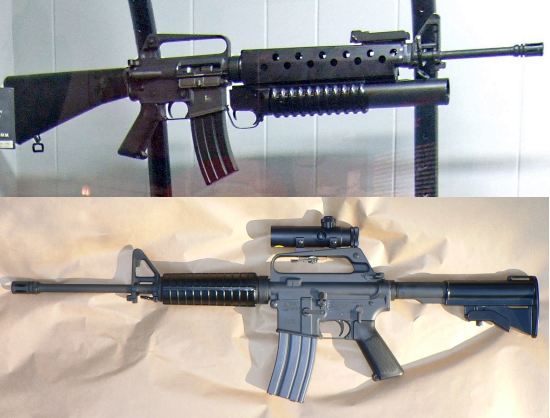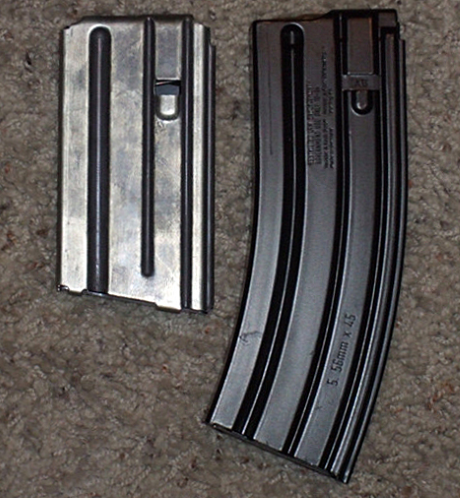M16 vs AR15…there are varying opinions as to which of these assault rifles is the most effective in combat.
The M16 was first introduced during the Vietnam War and has a long history with the U.S. Armed Forces.
On the other hand, the AR-15 rifle is renowned in both the military and civilian world.
The 2 semi-automatic weapons rival each other in terms of design, magazine capacity, range and accuracy, reliability, and other characteristics.
Learn more about each rifle in an in-depth comparison.
Related Article – 10 Best Lasers For AR-15 Rifles
Table of Contents
M16 vs AR15: 8 Biggest Differences

What weapon would you add to your arsenal in terms of M16 vs AR15?
Nevertheless, there is a frequent debate over which semi-automatic weapon is more deadly.
We’ve divided the M16 vs AR15 debate into 7 categories that examine the biggest differences between the rifles:
- History
- Purpose & Use
- Design
- Magazine Capacity
- Range & Accuracy
- Accessories
- Reliability
- Advantages & Disadvantages
Continue reading to learn more about the similarities and differences between the AR-15 and M16 rifle.
#1. History Of The M-16
The M16 rifle has a long connection with the U.S. Armed Forces.
It was designed in 1959 and officially entered military service in 1964.
Consequently, the M16 was used in jungle warfare operations that took place in Vietnam.
By 1969, the M16A1 became the standard service rifle of the U.S. Armed Forces.
Later, the U.S. Marine Corps adopted the M16A2 variant in 1983 with the Army following in 1986.
The newer version (M16A2) is notorious for its improved cartridge, barrel, handguard, and rear adjustable sight.
Finally, the fourth generation version (M16A4) was adopted into service in 1997.
Today, the M16 is widely considered one of the best semi-automatic weapons in the military.
The dependable M16 has been adopted by numerous other armed forces with approximately 8 million rifles produced.
In fact, the M16 is the most produced 5.56 mm caliber firearm in the world.
Nevertheless, the M16 is slowly being phased out in front-line combat for the shorter/lighter M4 Carbine.
History of the AR-15 Rifle
Meanwhile, the AR-15 is another noteworthy assault rifle with a colored history.
The semi-automatic weapon was initially produced by Colt before many other firearm manufacturers took the design in the late-1970s.
Thus, while the patents have expired, Colt remains the sole manufacturer and trademark of the AR-15.
Recently, the AR-15 has had a controversial history in the United States since it has been used in several mass shootings.
However, the AR-15 has also been an important assault weapon for the U.S. Armed Forces.
The primary difference between the civilian and military versions of the AR-15 is “select fire.”
The function enables military personnel to switch between multiple firing modes (semi-automatic, automatic, and burst fire).
In the end, there is no question that the AR-15 is extremely lethal.
The New York Times has defined the AR-15 rifle as “one of the most beloved and most vilified rifles” in U.S. history.
Related Article – 8 Best AK-47 Rifle Variants
#2. Purpose & Use

The M16 assault rifle was first introduced to the military in 1964.
It was designed by Eugene Stoner (who created the AR-10) and L. James Sullivan (AR-15).
The M16 was first produced by Colt Manufacturing Company yet is now built by several different manufacturers.
Today, the rifle continues to remain active in military service even if the M4 Carbine is slowly replacing the M16.
Be that as it may, the M16 was the standard-issue rifle for the U.S. Armed Forces for nearly a half-century.
The assault rifle was heavily used in Vietnam and recently assisted military personnel in Iraq and Afghanistan.
At first, reliability issues were noted under the harsh conditions of jungle warfare.
However, corrections to the cartridge were made with the M16A1, which helped improve overall performance.
It’s been said that the M16 saved the lives of 20,000 servicemen during their time in Vietnam.
Moreover, the M16 (and its many variants) are heavily utilized by the rest of the world.
In fact, the M16 is the most commonly manufactured 5.56x45mm rifle in the world.
The M16 is used by 15 NATO member countries at a total of 80 nations across the world.
Impressively, it’s estimated that more than 8 million M16 rifles have been produced across the globe.
On the other hand, the AR-15 was first developed by Colt in the late-1950s.
Initially, civilian sales were poor, but the adaptation of a military version fueled the popularity of the AR-15.
The military version features Select Fire, allowing personnel to switch between semi-automatic, automatic, or burst fire.
It has been heavily used both in the military and civilian circles for various purposes.
#3. M16 vs AR15: Design
The original M16 rifle was adapted from the design of the ArmaLite AR-15.
It features a revolutionary 5.56x45mm barrel with 20 rounds of semi-automatic fire.
The intention was to develop an air-cooled, gas-operated rifle that was also magazine fed.
The internal piston action of the firearm takes inspiration from the ArmaLite AR-10 and AR-15.
At the time of conception, the bolt carrier, gas system, and bolt-locking design were all unique creations.
Since that time, the variants of the M16 (i.e. M16A1) have become even more revolutionary.
The M16A1 weighs a little more than 8 lbs., even with a loaded 30-round magazine.
On the other hand, the M16A2 weighs more because of a thicker barrel designed to resist more damage (as well as not overheat).
The adjustable rear sight and handguard are also considered far more improved on the M16A2.
Moreover, the M16A2 features the same firing switch mode (semi-auto, 3-round burst fire) as the AR-15.
Lastly, the fourth generation (M16A4) is equipped with a Picatinny rail for mounting optics.
As for the AR-15 rifle, it has undergone a variety of alterations since its original design.
The traditional AR-15 is chambered in .223 Remington or 5.56x45mm NATO.
However, several other calibers exist depending on the need.
Furthermore, military models vary noticeably with the ability to switch firing modes.
Additionally, most components are interchangeable between the various firing options.
Colt was the original producer of the ArmaLite Rifle yet after losing its patents is now manufactured by several other companies.
#4. Magazine Capacity

The magazine of the M16 is supposed to not weigh much, like the rest of the lightweight assault rifle.
For this reason, the initial magazines were composed of aluminum before different alterations occurred.
First, the M16 was capable of firing a 20-round magazine but has since been upgraded to 30 rounds.
Notwithstanding, there are valid complaints regarding the reliability of the M16.
In the past, the magazine follower was known to rock or tilt, leading to malfunctions.
The latest version is reported to provide a 300% increase in reliability with the M4 Carbine.
Secondly, the AR-15 has been sold in various formats and depends on if the rifle is for commercial or military use.
For example, the first AR-15 rifle sold commercially only featured a 5-round magazine.
However, the typical Colt AR-15 that most recognize is loaded with a 20-round box magazine.
The different AR-15 variations include a completed lower receiver and stripped lower receiver.
You can distinguish the type of AR-15 based on the location of the trigger guard.
The AR-15 features a magazine well that supports detachable magazines.
The magazines are interchangeable between the semi-auto and select fire AR-15s.
#5. Range & Accuracy

M16 vs AR15 – Which assault rifle is more dangerous in terms of range and accuracy?
Despite some concerns about the magazine, the M16 replaced a much heavier M14 rifle.
Consequently, it was less strenuous for soldiers to handle while being able to carry more ammunition.
Thus, the M16 is considered extremely accurate for a standard-issue military rifle.
The M16 produces a light recoil with high velocity/flat trajectory fire that accurately completes head shots from 300 meters.
Furthermore, new versions can increase the range and accuracy of the M16 to 600 meters.
The latest edition of the M16 pushes its lethal firing range to just under 1,000 yards.
It may give the rifle an edge in the M16 vs AR15 debate since the M16 is the longest continuously serving rifle in U.S. military history.
In fact, most of the world considers the 5.56x45mm cartridge the global standard for NATO forces.
Meanwhile, the AR-15 is also coveted for its lethal firing range and accuracy.
The AR-15 was designed with .22-caliber bullets that destabilize when they connect with the human body, as opposed to a .30 round.
The smaller caliber of the AR-15 allows the assault rifle to wreak havoc as it’s 1/3rd the weight of a .30 caliber rifle.
Moreover, the reduced bolt thrust and free recoil produces an extremely accurate assault weapon.
Trials reveal that the AR-15 can fire 600-700 rounds in a minute with a low chance of jamming.
The firing distance of an AR-15 varies greatly depending on several factors including the makeup of the rifle and caliber ammunition.
Moreover, the individual skill and marksmanship of the shooter will also play a role in accuracy and distance.
Nevertheless, a standard military-spec AR-15 (.223 chamber) is capable of reaching 400-600 yards.
#6. M16 vs AR15: Accessories
The most recent innovations in firearms have largely been in developing optics and other gun accessories.
As a result, it’s not surprising that the AR-15 and M16 have a feature of add-ons.
For starters, military personnel can equip either rifle with muzzle devices such as a flash or sound suppressor.
Soldiers can even mount current M16 rifles with a 40mm grenade launcher (M203, M320).
Meanwhile, the under-barrel supports 12-gauge shotguns (M26 Modular Shotgun System, KAC Masterkey).
Finally, there is even an option to attach the M16 with a bayonet (M7 Bayonet) or transform it into an ad-hoc automatic rifle (XM3 bipod).
Often, the assault rifle is equipped based on certain standards such as NATO guidelines.
For example, the Picatinny rail STANAG 2324 supports a standard mounting platform for scopes, night vision, tactical lights, laser aiming modules, and other accessories.
The AR-15 supports a diverse range of options for accessories, too.
Gun owners have the option of purchasing an AR-15 “stripped” which means the lower receiver is a single solid part that supports a variety of kits.
Thus, individuals frequently equip an AR-15 with their own fire control group and other components.
Then, on the top side of the AR-15, an upper receiver features a bolt carrier assembly that is attached to the barrel.
There, individuals have the ability to connect sights, handguards, and other optics.
#7. Reliability

You cannot ignore some of the differences in reliability when it comes to the M16 vs AR15 debate.
It’s worth noting that the initial reception of the M16 was not fantastic, particularly in Vietnam.
While the intentions were good, the lightweight design caused some of the internal parts to malfunction.
Thus, it was common to deal with gun jams or other issues that affected reliability.
Thankfully, the DoD invested significant research into the M16 to alleviate several of the performance problems.
The magazine, gas system, and other components of the M16 have vastly improved over the decades.
In fact, the plan to replace the M4 Carbine with the M16 standard-issue military rifle is due to reliability issues with the M4.
Then, there is the conversation over how the AR-15 performs in terms of reliability.
Research has indicated the AR-15 is extremely reliable even in rapid fire where hundreds of rounds are unleashed per minute.
Previously, the AR-15 has been well received by the military thanks to its lightness and reliability.
Be that as it may, there is some criticism that the AR-15 is not as accurate at long ranges as the M16.
The M16 and AR-15 both maintain an important rank in the history of warfare.
The 2 assault rifles have served men well on the battlefield and continue to evolve as modern warfare changes.
There is little debate that the M16 was a game-changer when it was first designed and adopted into the military.
Despite some initial struggles in the harsh jungle conditions of Vietnam, the M16 has remained reliable.
The air-cooled, gas-operated, magazine-fed assault rifle composed of steel and aluminum alloy was completely innovative at the time.
It has inspired virtually every other country on the planet to design a comparable small-caliber, high-velocity assault rifle.
On the other hand, the AR-15 carries a stellar reputation despite some recent controversy.
While the assault weapon has been involved in some high-profile shooting incidents, the vast majority of AR-15 owners are responsible.
They understand the pure magnitude and lethality of these rifles.
AR-15 rifles are produced from a variety of manufacturers yet the original Colt design remains legendary.
The AR-15, like the M16, has undergone several variations and will continue to adapt to a changing climate.
In fact, it was recently announced that the U.S. Army plans to replace the M16 with the SIG MCX SPEAR.
Therefore, the AR-15 will need to continue and evolve or fear extinction like so many classic rifles beforehand.
Conclusion: M16 vs AR15 – The Best Assault Rifle?
M16 vs AR15?
Which small-caliber, high-velocity assault rifle takes the prize for top honor?
It’s difficult to ignore the long history and heralded reputation of the M16.
The M16 rifle has adapted after a rough start and represents the longest continuously used rifle in the military.
Then, you have to consider the advantages of the AR-15.
It’s highly regarded for offering outstanding reliability and performance.
The AR-15 is lightweight and accurate with the ability to customize in many regards.
The interchangeable components and wide range of optics make the AR-15 very lethal.
You be the judge… which rifle do you prefer?
Images
- Ikon Pass Military Discount: Learn How To Save Big - January 31, 2025
- RTIC Military Discount: Find Out How To Save Big on Gear - January 30, 2025
- Traeger Military Discount: Learn How To Save Big on Smokers - January 28, 2025


